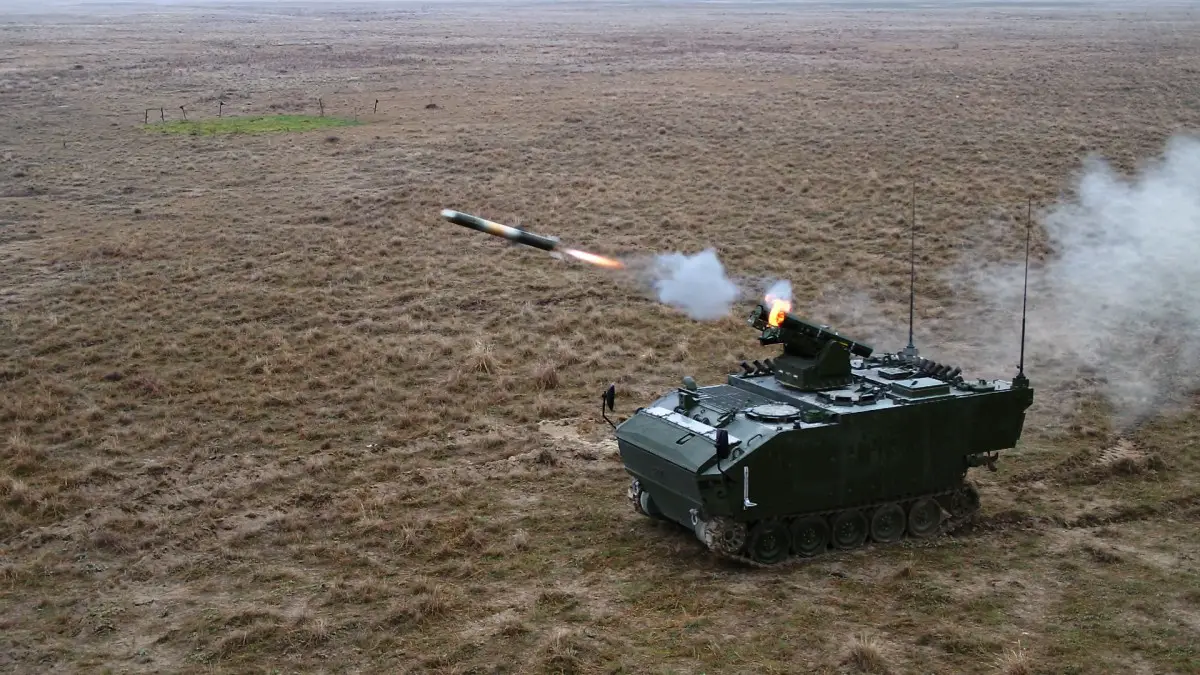The Turkish Army has initiated the deployment of the KAPLAN STA Anti-Tank Vehicle, marking a crucial addition to its arsenal. The vehicle is based on the tracked armored vehicle Kaplan-10 fully designed and manufactured by the Turkish company FNSS. In June 2016, The Turkish Undersecretariat for Defense Industries (SSM) has awarded the Turkish Company FNSS Defense Systems a contract for the delivery of 260 armored vehicles including 76 Pars 4×4 and 184 Kaplan 10 tracked armored vehicles. Along with the vehicles, 64 anti-tank missiles Kornet E turrets and 196 medium-range anti-tank weapon systems, OMTAS turrets entered into service with the Turkish Armed Forces. Its recent delivery to the Turkish armed forces underscores the nation’s strides in enhancing its defense capabilities. KAPLAN STA is developed by FNSS to meet the stringent requirements of the Turkish Armed Force. KAPLAN 10 has a low silhouette, and has the ability to operate at high speed, not only on asphalt but also on soft soil, or muddy and rough terrains under all weather conditions.

The Kaplan STA Anti-tank is fitted with ARCT(Anti-Tank Remote-Controlled Turret). The ARCT is fitted with a fully stabilized and electrically powered remotely operated weapon station which is equipped with two launcher tubes able to launch anti-tank guided missiles such as the Russian Kornet-E, the Turkish MIZRAK-O, the Ukrainian SKIF, or other anti-tank guided missiles. Equipped with two anti-tank guided missiles and a 7.62mm coaxial machine gun, the ARCT offers a 360-degree traverse capability. Its digital fire control system ensures precise ballistic calculations, optimizing hit probability for both missiles and the machine gun. A bank of four smoke grenade dischargers is mounted at the front right side of the hull and another bank of eight smoke grenade dischargers is mounted at the rear of the top hull. Further enhancing firepower and expanding mission range, the turret’s secondary armament supports automated functions from within the vehicle. The turret’s digital electric drive system and two-axis stabilization bolster accuracy during mobile firing.

The KAPLAN Anti-Tank Vehicle (STA) is the smallest member of the KAPLAN new-generation armored combat vehicle family developed by FNSS. The vehicle is 5.6m long, 3m wide, and has an overall height of 3.1m. The KAPLAN 10 is one of the very few vehicles to have amphibious characteristics. Thanks to the two water propulsion systems located at the rear of the vehicle, KAPLAN 10 can perform in deep and fast-flowing waters. The vehicle can enter the water without any prior preparation, and thanks to its two rear-mounted propulsion systems, it can move in deep and fast-flowing streams. The rear part of the hull can accommodate three soldiers to perform all the firing operations from inside of the vehicle. The rear part of the vehicle is fitted with a hydraulic ramp which is used by the crew and soldiers to quickly enter or leave the vehicle. The hull of the KAPLAN STA Anti-Tank is manufactured and integrated using a ballistic welding technique providing protection against the firing of small arms, artillery shell splinters, and blasts of mine or IEDs (Improvised Explosive Devices) explosion.

The KAPLAN STA Anti-Tank is motorized with a Diesel engine coupled to a fully automatic transmission. It can run at a maximum road speed of 65 km/h with a maximum cruising range of 525 km. The maintenance and repair of the powerpack is carried out via the cabin access hatch. For balance, the two fuel tanks are located at the rear and are fully armored and isolated from the vehicle to ensure the security of personnel. The vehicle is fully amphibious and is powered in the water at a maximum speed of 6.3 km/h thanks to two water propulsion systems located at the rear of the vehicle. The torsion bar suspension consists on each side of five road wheels with a track return roller at the front and idler at the rear. The advanced suspension track system is designed to reduce vibrations and improve road holding. The vehicle can climb a gradient of 70 % and a side slope of 40. It can climb a vertical obstacle of 0.75 m and cross a trench with a length of 1.8 m.
















